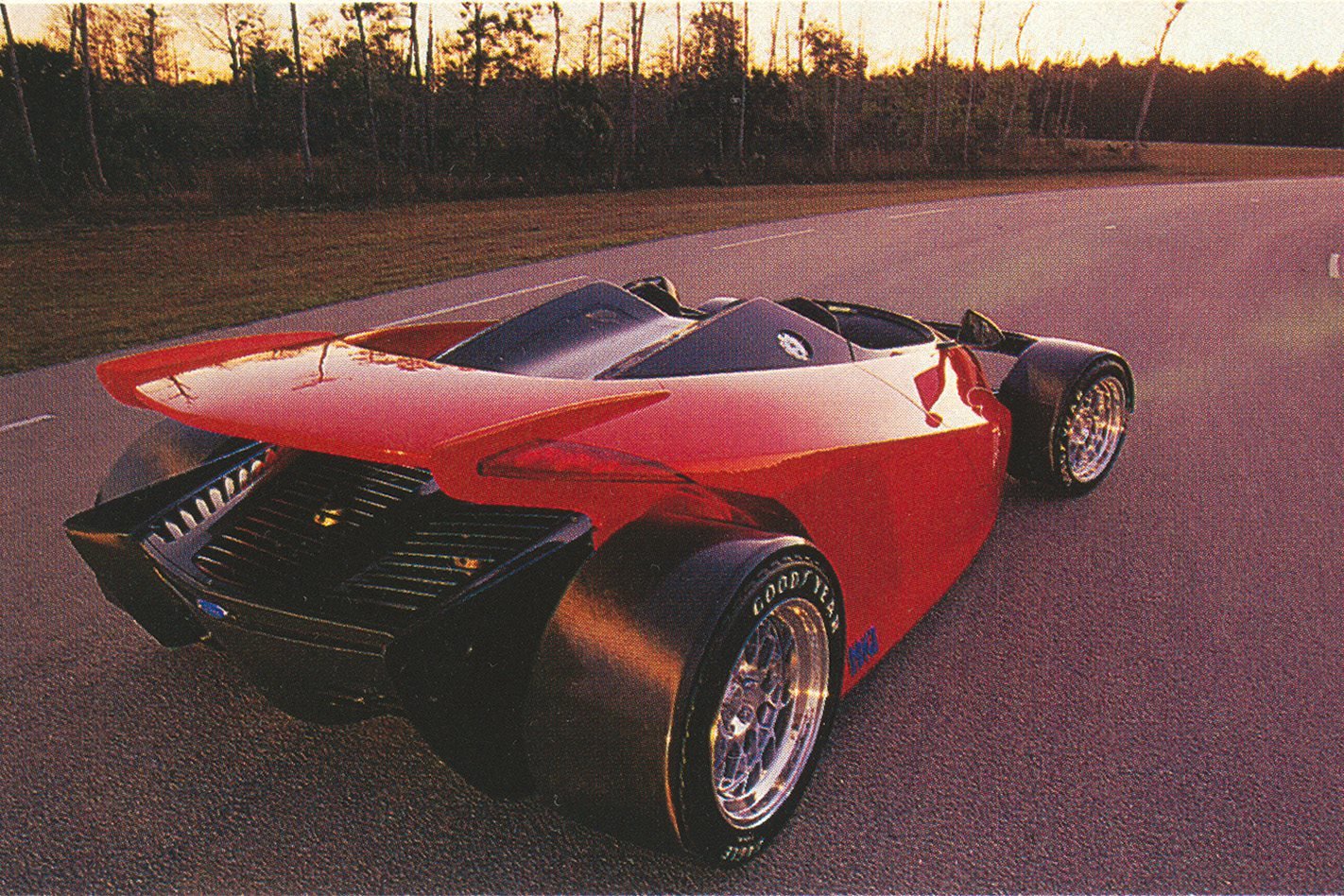This article first appeared in Wheels’ May, 1996 issue.
This V12 doesn’t howl, it snarls. There’s a menacing basso boom in the exhaust note that’s barely diminished by the roar of the wind in my ears, and an edgy snap, crackle, pop on the overrun as I lift off the throttle for the corners.
The fat rimmed Nardi steering wheel squirms in my hands, the front end kart-darty quick as it dives for the apex.
It turns in just like that; no waiting, no delay, no roll. But get on the gas too early and the front end starts to push wide as that fabulous V12 grunts towards its torque peak of 549Nm at 5250rpm.
Max power is 340kW at 6100rpm, and the delivery is wonderfully smooth and linear up through the gears. It’s perhaps not quite as fluid as the superb flat 12 in Ferrari’s F512M, which develops a mere
328k W at 6750rpm and 498Nm at 5500rpm. But it’s not bad for a Ford…
That’s right, a Ford. The twin cam, 6.0-litre V12 in Ford’s radical Indigo concept car is basically two Taurus V6s joined end to end.
Sure, there’s a new block and heads, cast in aluminium by Cosworth Engineering, along with a new crank and camshafts. But the basic architecture, plus internals such as pistons, conrods, valves, etc, are straight from the Taurus’ Duratec V6.
Running on high octane unleaded, Ford says the Indigo’s engine delivers grunt enough to propel the car to 100km/h in less than 3.9 seconds, and cover the standing 400m in just 11.9.
For the record, the F512M is about a second slower on both counts.

The Indigo’s engine is significant because it’s the one element of this wild F1 car for the road likely to end up as production reality.
Sources inside Ford engineering confirm the V12 is under development for use in the forthcoming Lagonda luxury car as well as a high performance Vantage version of the Aston Martin DB7 – critically important, as the standard DB with its 3.2 litre supercharged six is likely to be shaded by the newer, cheaper V8-powered Jaguar XK8.
The V12 program is being run by Ford Advanced Engine Engineering director Jim Clark, who has also visited Ford Australia three or four times in the past 18 months or so to check on development of the next generation Falcon engine (which will probably be another straight six).
At least five V12s have been built so far and, although it’s still very early in the development cycle, engineers are confident of achieving more than 370kW.
Indigo was originally conceived to steal Chrysler’s thunder at this year’s Detroit show. With cars like Viper and Prowler, plus a raft of innovative new generation production cars such as LH, Neon and the new Minivan, Chrysler has made Detroit, now arguably the world’s most important motor show, its own over the past few years.
Ford product chief Jae Nasser, among others, was determined not to let it happen again.
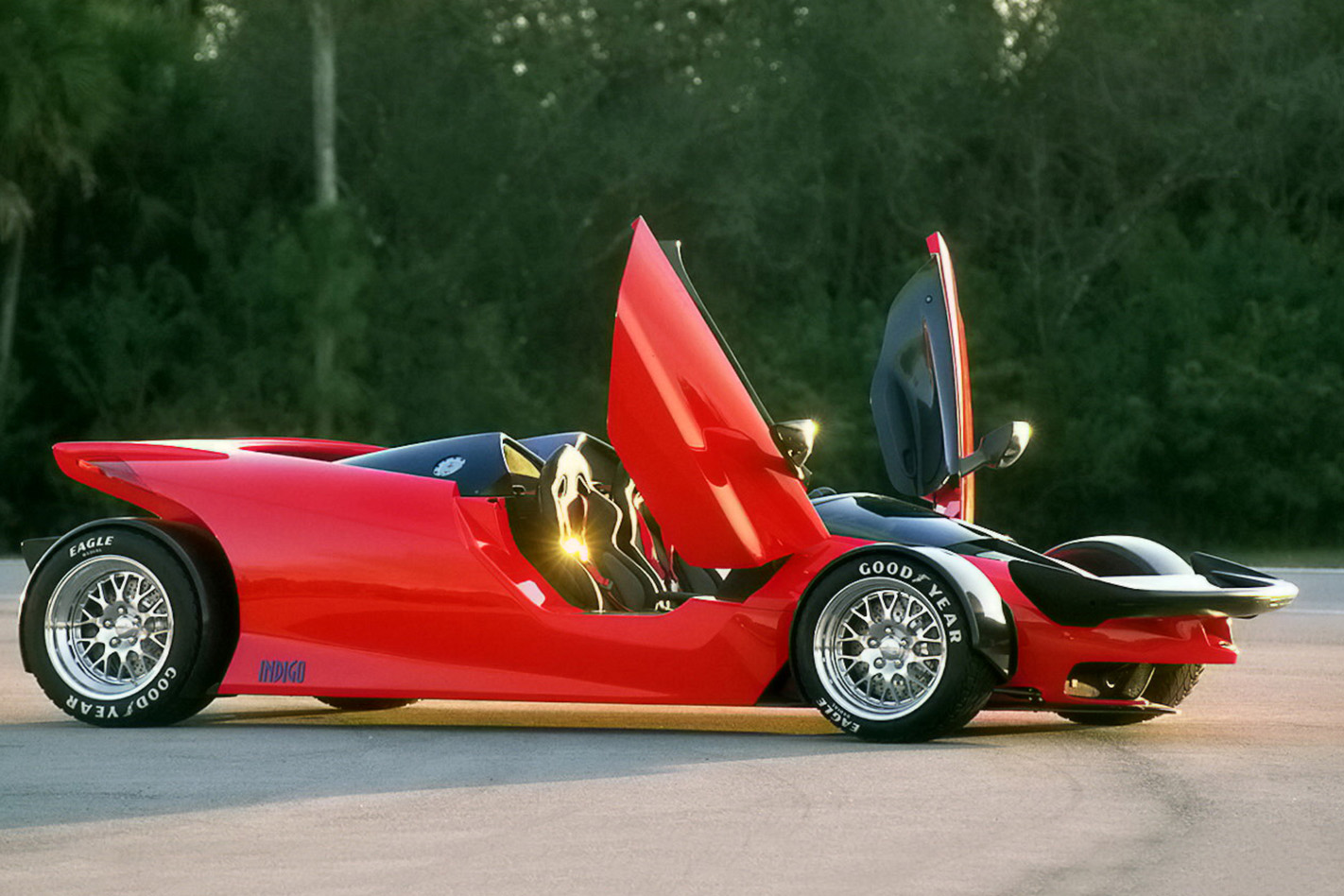
Indigo’s race car look is the work of a very small team: Mark Adams, who runs Ford’s advanced styling studio; John Hartnell, who penned the radical new Ka small car, one of the first of the Jae Nasser Fords to reach production; exterior designers Jeff Puppas and Jim Smith; and Australian Shareen Rapaport, who was responsible for colour and trim.
Right from the beginning, the Indigo program – originally known internally as TSC – was intended to showcase the V12.
“The first thing we worked on was a sports car project,” says Adams. “We drew big, hairy roadsters, coupes, supercars like the Diablo, but we weren’t getting anywhere. Then we watched Indy (won by Jacques Villeneuve in a Reynard-Ford) and- bingo! We had the idea.”
While Chrysler’s Prowler leaps back to the future with retro-rod styling, Indigo (Indy-go – geddit?), represents the first serious attempt to capture the flavour of a modem, open-wheeled race car on the street.
The red painted carbonfibre bodywork sweeps up and back from an aggressively chiselled nose into a freestanding wraparound rear wing with tail lights artfully integrated into the trailing edge. Carbonfibre engine cover and tyre hugging cycle guards enhance the impression of minimal bodywork.
The high mounted front wing, redolent of the one fitted to the 1971 March 701 grand prix racer, is the Indigo’s defining design statement; without it the car could just be another wedgy roadster.
It’s a cleverly multi-functional device, too, acting as a bumper and mounting point for the optical fibre spotlights and indicators. The headlights – which also use optical fibres to transfer light from the source box buried deep in the nose – are concealed in the external mirror housings.
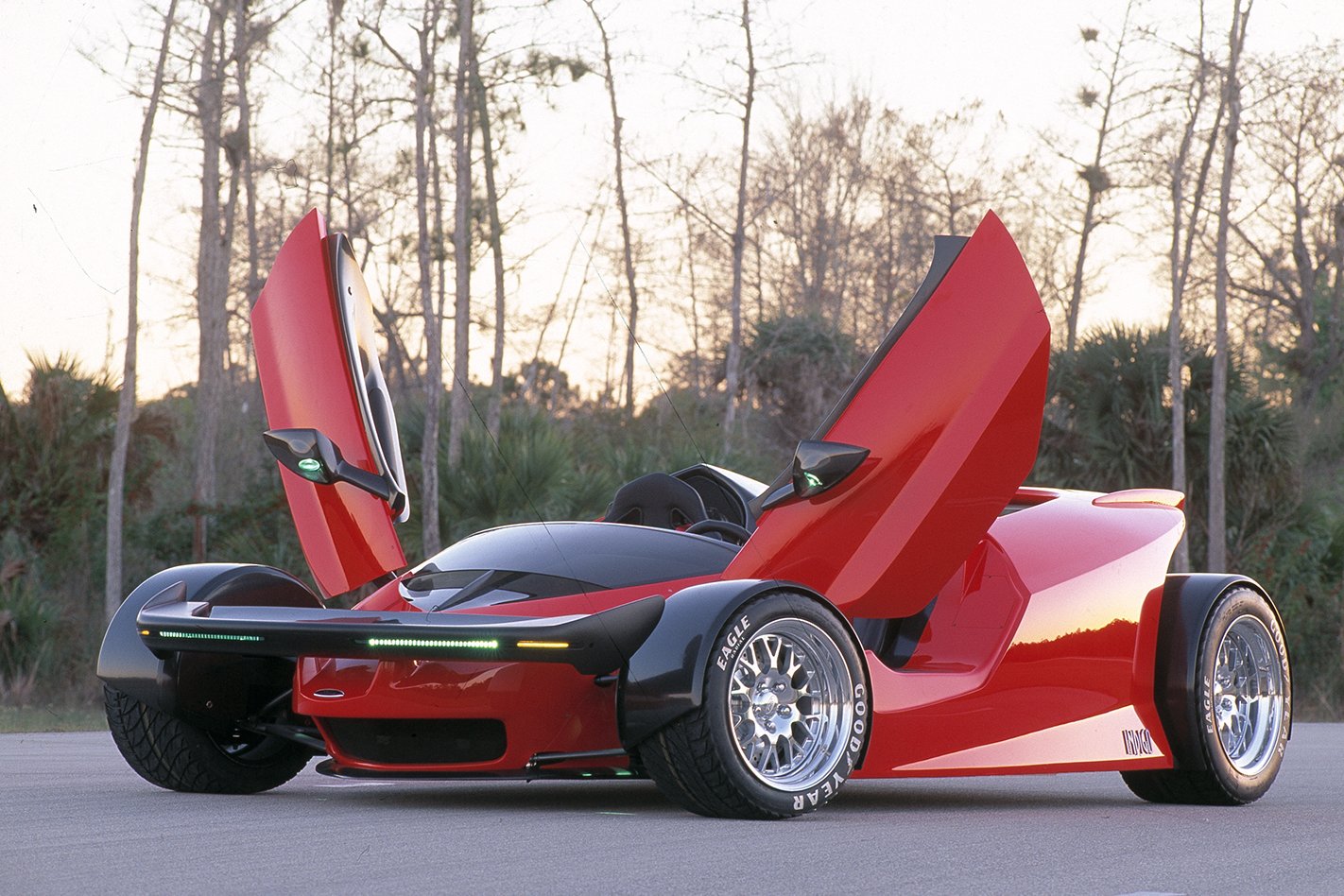
Ironically, the stuff which most closely links the Indigo to a modern open wheeler is all out of sight. There’s the carbon-fibre composite, aluminium honeycomb monocoque chassis, for example, designed and built by Reynard.
The suspension is pure IndyCar, with fabricated double wishbones front and rear and pushrod actuated coil-over shocks.
Attached to the hub carriers are massive vented and cross drilled Brembo discs, 335mm up front and 356mm at the rear.
The wheelbase – 2895mm – is about line ball with current IndyCar practice.
And like the new Zetec V10 fitted to the Sauber F1 cars, the Indigo V 12 is a stressed chassis member, being bolted directly to the monocoque and carrying all the rear suspension loads.
The gearbox is an Indycar Hewland sequential shift six-speed, modified to accept an F1-style steering wheel-mounted paddle shift system, although a manual clutch is retained.
Packaging two passengers while attempting to meet US side impact regulations makes the Indigo monstrous by F1 standards. It looks bulky — and it is. Being wider than a Falcon through the body section alone.
Add in the wide track and fat 355/30ZR18 rear tyres, and you’re occupying almost 2.1-metres of road.
Clamber across the huge sills and the interior is remarkably roomy and civilised. The hip-hugging seats feature power fore/aft adjustment, and there’s a mini-disc player hidden away under a flap in the dash.
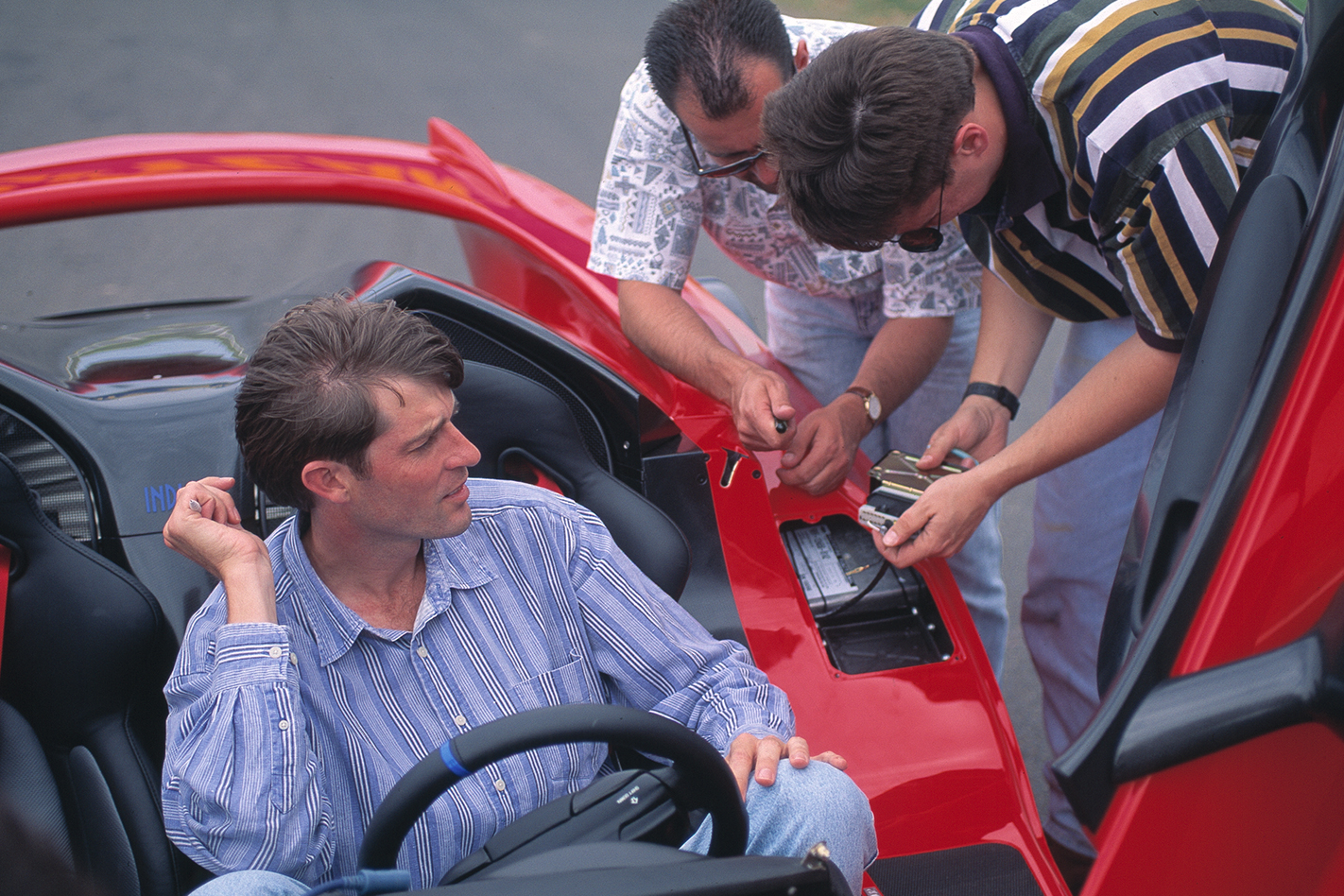
An F1-style LCD panel developed by Ford Electronics gives a digital readout for gear position, speed and water temperature, plus a bar readout of engine revs. The tacho readout goes to 7000rpm. Ford says the redline is 6500.
The pedals are beautifully made alloy pieces, hinged at the bottom and perfectly placed for heel and toe downshifts. They look straight out o fa race car. They are, in fact, from a Reynard F3000.
The view from the driver’s seat is fantastic. You see the front wheels, just out there past the soles of your feet, jiggling slightly as the stiff suspension tracks over lumps and bumps, and turning instantly as you move the steering wheel.
With no bodywork to interrupt the view, the Indigo can be placed with millimetric accuracy in corners.
Unlike the Detroit show car, there’s no windscreen on this Indigo, which makes a full-face helmet mandatory for all but slow laps.
But the noise and the windrush, even when playing around in second and third gears, are intoxicating.
With a helmet on, it’s easy to imagine you’re Michael Schumacher. which is precisely how the Indigo team wants you to feel.
Ford talked at Detroit of putting the Indigo into limited production, as Chrysler did with Viper and Prowler. But despite the suggestion that 700 cars could be built over three years, hitting the market at $100,000 each — a bargain basement price for a car of this brazen eye appeal and shattering performance, given a Ferrari F512M retails for almost twice that — it now seems Ford lacks the courage of its convictions.
Where insiders close to the project once enthusiastically claimed Indigo had a 75 percent chance of being built, they now say that probability has dwindled to 20 percent.
All is not lost, however — while Indigo now seems almost certain to be consigned to the same Ford show car cul dc sac asthe quad-turbo GT90 shown at Detroit last year, that marvellous V12’s still looking good…

Laps of memory
Pungent, sticky oil was smeared all over the back of the Indigo’s shapely carbon-fibre rear end. “Don’t worry,” said Derek Fowler, the man responsible for fettling this priceless prototype,” it wouldn’t be a Hewland gearbox if it didn’t leak oil…”
Fowler knows his Hewlands. He also knows the Indigo. Which explains why he’s here at windswept Calder instead of back home in windswept Detroit.
Fowler was working in the NVH department of Ford’s Advanced Engineering when the Indigo was first rolled out for an in-house showing.
His experience of Hewlands in IndyCar racing — he worked for Chip Ganassi’s team and was part of the crew which helped Michael Andretti to victory in the rain-delayed IndyCar Grand Prix at Surfers Paradise in 1994 — soon earmarked him as caretaker of the Indigo, at least for its stint in Australia.
In a brave move, Ford’s Australian PR decided to also allow Sauber-Ford grand prix drivers Heinz-Harald Frentzen and Johnny Herbert, plus local Ford touring car aces Dick Johnson and John Bowe, to chauffeur journalists and company heavies around Calder’s short circuit.
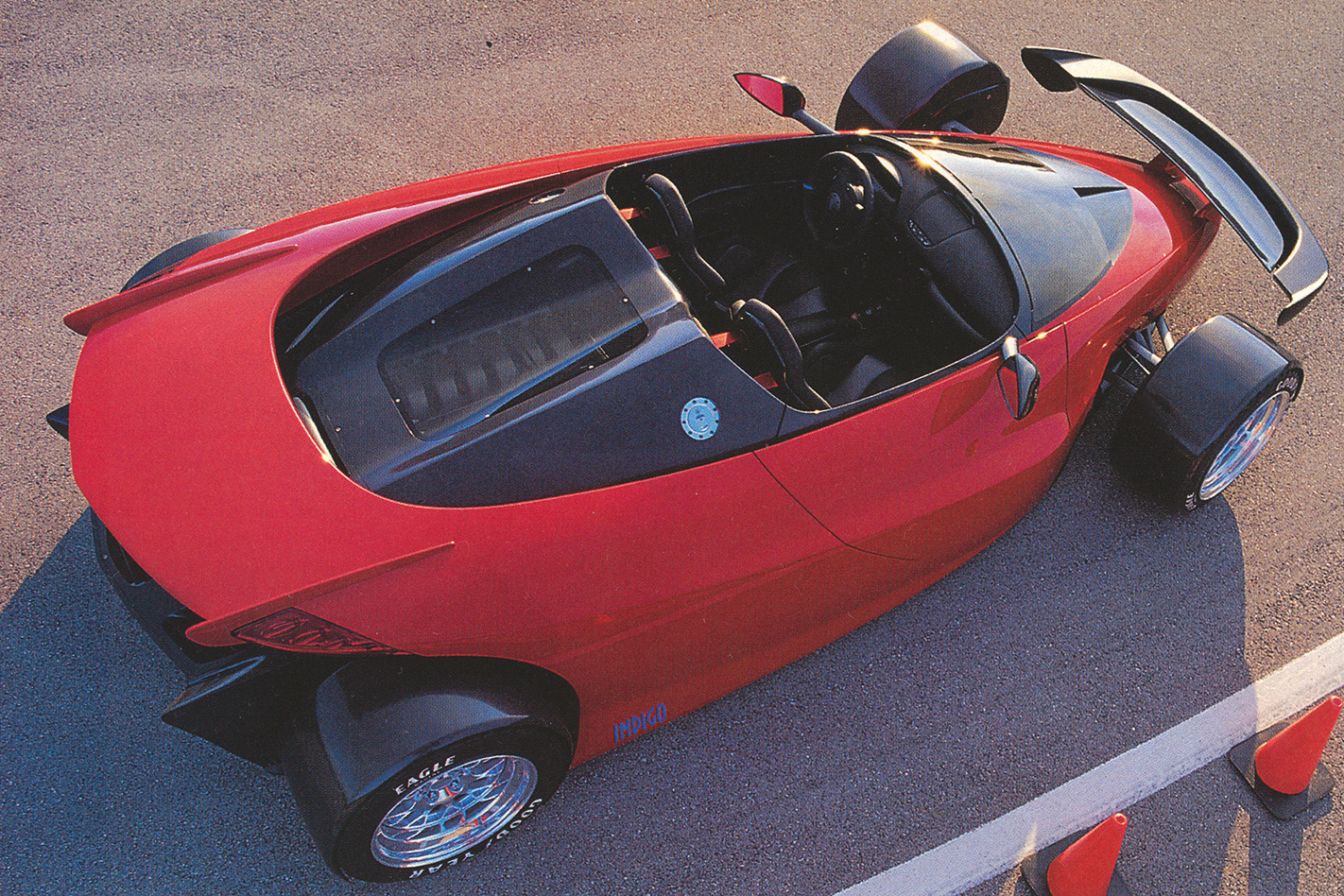
A leak in the nitrogen gas pressure accumulator which actuated the shift meant we had to use a temporary cable-operated lever instead of the steering wheel paddles. But apart from that glitch the Indigo ran perfectly for almost three hours solid, taking passengers for lap after rapid lap of the tight Calder track.
It was a remarkable performance for a car which had barely covered 50 kilometres before arriving in Australia.
By the time we were allowed in the cockpit for our exclusive drive, however, the Indigo was a bit tired.
The gearshift was spongier than ever, and both cooling fans had mysteriously died. With 12 cylinders and 6.0-litres, it didn’t take long for the engine to start overheating.
Our time in the car was therefore disappointingly brief. But unforgettable all the same.


